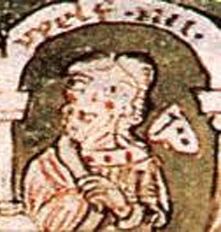Name Welf Duke | ||
 | ||
Spouse Judith of Flanders, Countess of Northumbria (m. 1071–1094), Ethelinde, daughter of Otto II, Duke of Bavaria (m. 1062) Children Welf II, Duke of Bavaria, Henry IX, Duke of Bavaria, Kunizza of Bavaria Siblings Fulco I, Margrave of Milan Parents Albert Azzo II, Margrave of Milan, Kunigunde of Altdorf Similar People Henry IX - Duke of Bavaria, Tostig Godwinson, Baldwin V - Count of Flanders | ||
Welf I (died 6 November 1101, Paphos, Cyprus) was Duke of Bavaria from 1070 to 1077 and from 1096 to his death. He was the first member of the Welf branch of the House of Este. In the genealogy of the Elder House of Welf he is counted as Welf IV.
Welf was the son of Azzo II of Este and his wife Kunigunde of Altdorf. When Welf's maternal uncle, Welf, Duke of Carinthia (also known as Welf III), died childless, Welf inherited his property. Welf married Ethelinde of Northeim, daughter of Otto II, Duke of Bavaria.
Although the Marquis of Este, guided by his cousin Matilda, continued firm in the pope's interests, his son Welf, who had succeeded to the Bavarian states, and whose views were more immediately directed to Germany, supported the emperor.
When his father-in-law, Duke Otto had become an enemy of King Henry IV and forfeited his duchy, Welf remained loyal to the king. In compliance with Henry's commands, he repudiated and divorced his duchess, Ethelinde, and soon thereafter (in 1070) he was rewarded for his fidelity by being appointed Duke of Bavaria in Otto's stead. This event took place at Goslar in 1070, when the States of Bavaria submitted quietly to the newly made duke, who was the representative of one of the most ancient families in the province. His repudiation of the duchess, which could have been considered an act of injustice, does not seem to have been held against him.
During the Investiture Controversy, however, Welf changed sides, turning against the emperor — supporting Pope Gregory VII as well as lending his support for the election of Rudolf of Rheinfelden as anti-king in March 1077. Pope and emperor were superficially reconciled in 1076, but the following year saw them again engaged in active hostilities. Henry, in consequence of these repeated acts of rebellion, declared Welf deposed in his newly acquired duchy. However, supported by his faithful Bavarians, and aided by his father in Italy, Welf was able to maintain his place, and openly defy the ban of the empire in May 1077.
Welf joined the discontented princes who supported the standard of Rudolph, at a time when any who refused to follow the pope's direction could expect to be excommunicated by the church — a potent and effective threat in the social and political conditions of the time. However, Gregory died in 1085 and his successors took a less intensive part in the affairs of Germany. Welf, though still adhering to the party of the church, began to relax in his exertions to maintain the anti-king.
After the divorce, in 1070, from his first wife, Welf married Judith of Flanders, daughter of Baldwin IV, Count of Flanders, and the widow of Tostig Godwinson, Earl of Northumbria.
In 1089, Welf's son Welf married Matilda of Tuscany, thus strengthening relationships with the pope. However, after the younger Welf divorced Matilda in 1095, Welf made amends with King Henry IV and was reconfirmed in his position as Duke of Bavaria.
After the death of his father Azzo in 1097, Welf tried to acquire his father's property south of the Alps, but did not succeed against his younger half-brother Fulco.
In 1099, Welf joined what would become known as the Crusade of 1101, along with William IX of Aquitaine, Hugh of Vermandois and Ida of Austria. His main success was to prevent a clash between fellow Crusaders, who had been pillaging Byzantine territory on their way to Constantinople, and the Byzantine emperor's Pecheneg mercenaries.
The Crusade itself, entering Anatolia, ended disastrously; after passing Heraclea in September, Welf's Bavarians — like other crusader contingents — were ambushed and massacred by the Turkish troops of Kilij Arslan I, the Seljuq Sultan of Rûm.
Welf himself escaped the fiasco, but died on his way back in Paphos, Cyprus, in 1101 and was buried in Weingarten Abbey. He was succeeded as Duke of Bavaria by his son Welf.
Children
Welf had the following children from his marriage with Judith of Flanders, daughter of Baldwin IV, Count of Flanders:
